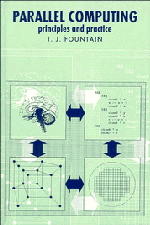2 - The Paradigms of Parallel Computing
Published online by Cambridge University Press: 29 September 2009
Summary
The Shorter Oxford English Dictionary defines the word paradigm as meaning pattern or example, but it is used here in its generally accepted sense in this field, where it is taken to imply a fundamental technique or key idea. This chapter, therefore, is concerned with describing the fundamental ideas behind the implementation of parallel computation.
Two matters need to be dealt with before we begin. First, the reader should avoid confusion between the basic approaches set out in Chapter 1 and the paradigms described here. In the final chapter of this book, I develop a taxonomy of parallel computing systems, i.e. a structured analysis of systems in which each succeeding stage is based on increasingly detailed properties. In this taxonomy, the first two levels of differentiation are on the basis of the three approaches of the first chapter, whereas the third level is based on the paradigms described here. This is shown in Figure 2.1.
Next, there is the whole subject of optical computing. In one sense, an optical component, such as a lens, is a data parallel computer of dedicated functionality (and formidable power). There is certainly an overlap in the functions of such components and those of, say, an image processing parallel computer of the conventional sort. A lens can perform a fourier transform (a kind of frequency analysis) on an image, literally at the speed of light, whereas a conventional computer requires many cycles of operation to achieve the same result.
- Type
- Chapter
- Information
- Parallel ComputingPrinciples and Practice, pp. 30 - 79Publisher: Cambridge University PressPrint publication year: 1994



